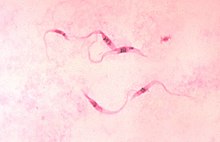Trypanosoma cruzi
| Trypanosoma cruzi | |
|---|---|
 |
|
| Trypanosoma cruzi, crithidia | |
| Scientific classification | |
| Domain: | Eukarya |
| (unranked): | Excavata |
| Phylum: | Euglenozoa |
| Class: | Kinetoplastida |
| Order: | Trypanosomatida |
| Genus: | Trypanosoma |
| Species: | T. cruzi |
| Binomial name | |
|
Trypanosoma cruzi Chagas, 1909 |
|
Trypanosoma cruzi is a species of parasitic euglenoids. Amongst the protozoa, the trypanosomes characteristically bore tissue in another organism and feed on blood (primarily) and also lymph. This behaviour causes disease or the likelihood of disease that varies with the organism: for example, trypanosomiasis in humans (Chagas disease in South America ), dourine and surra in horses, and a brucellosis-like disease in cattle. Parasites need a host body and the haematophagous insect triatomine (descriptions "assassin bug", "cone-nose bug", and "kissing bug") is the major vector in accord with a mechanism of infection. The triatomine likes the nests of vertebrate animals for shelter, where it bites and sucks blood for food. Individual triatomines infected with protozoa from other contact with animals transmit trypanosomes when the triatomine deposits its faeces on the host's skin surface and then bites. Penetration of the infected faeces is further facilitated by the scratching of the bite area by the human or animal host.
The Trypanosoma cruzi life cycle starts in an animal reservoir, usually mammals, wild or domestic, including humans. A triatomine bug serves as the vector. While taking a blood meal, it ingests T. cruzi. In the triatomine bug (Triatoma infestans) the parasite goes into the epimastigote stage, making it possible to reproduce. After reproducing through binary fission, the epimastigotes move onto the rectal cell wall, where they become infectious. Infectious T. cruzi are called metacyclic trypomastigotes. When the triatomine bug subsequently takes a blood meal from a human, it defecates. The trypomastigotes are in the feces and are capable of swimming into the host's cells using flagella, a characteristic swimming tail dominant in the Euglenoid class of protists.
The trypomastigotes enter the human host through the bite wound or by crossing mucous membranes. The host cells contain macromolecules such as laminin, thrombospondin, heparin sulphate, and fibronectin that cover their surface. These macromolecules are essential for adhesion between parasite and host and for the process of host invasion by the parasite. The trypomastigotes must cross a network of proteins that line the exterior of the host cells in order to make contact and invade the host cells. The molecules and proteins on the cytoskeleton of the cell also bind to the surface of the parasite and initiate host invasion.
...
Wikipedia
